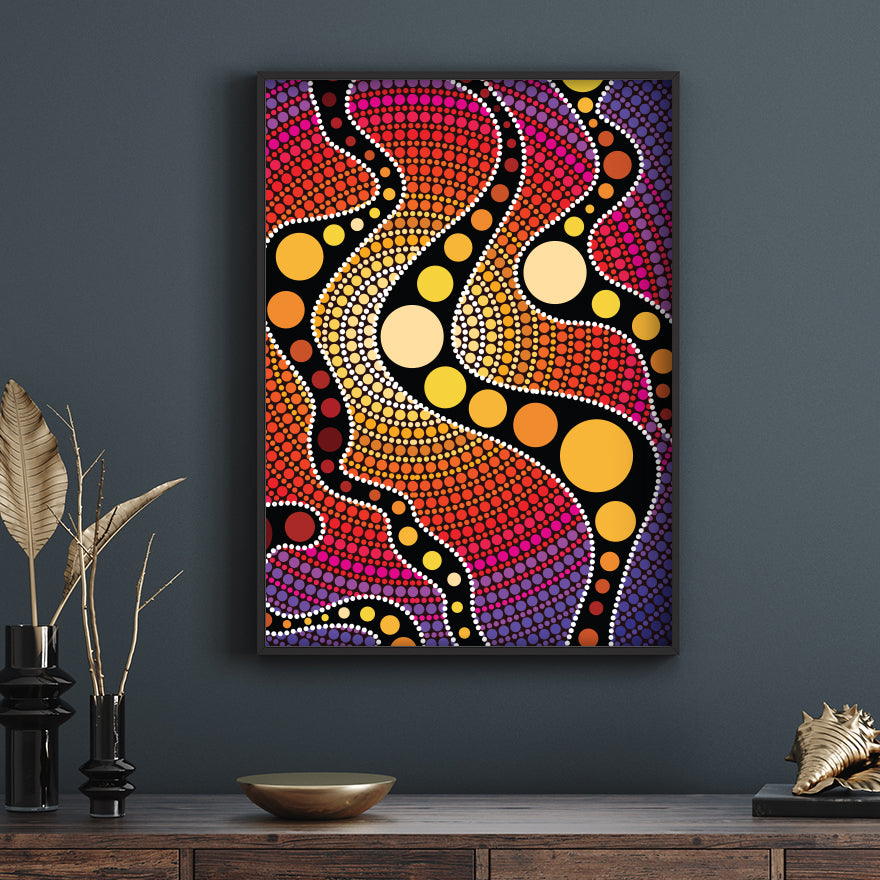Your Cart is Empty
- Our Services
- Shop Personalised Frames
- Corporate & Award Framing
- Gallery
- About Us
- Contact Us
- Visit Us

The art traditions of Australian Aboriginal and Torres Strait Islander people are some of the oldest in the world. In many cases, the artwork comes unframed so it is important to understand how to frame Aboriginal art in the best way.
Not only will framing your artwork properly mean that it’s displayed in the ideal way, it will also ensure the artwork is protected so that your investment retains value for years to come.
When purchasing Indigenous Australian art, it’s important to do so ethically. For many remote Aboriginal communities, selling artwork is one of their main sources of income. Purchasing artwork that benefits the communities is an important part of making sure that Indigenous art continues to thrive long into the future.
There are several ways to frame Indigenous art, depending on the material used and the final look you want to achieve. If it is a valuable piece of art, you should also consider framing methods that will help preserve the artwork.
Although more traditional works are done on bark, much of the artwork made by remote Indigenous communities today is done on unstretched canvas or linen.
There are two main ways to frame canvas art. You can stretch it over wooden stretcher bars and simply display as is, or you can add a floating frame around the stretched canvas.
Canvas stretching is the process of stretching a piece of canvas over wooden stretcher bars. Most canvas artworks are stretched before they are displayed to preserve the canvas and prepare it for framing.
It’s important that the correct size stretcher bars are used to achieve the right amount of tension. When the correct bars are used you do not need any brace bars to sit between the top and bottom of the frame.
If you want the artwork to curl around the sides of the bars so that the painting can be seen on the side of the canvas, you will need a deeper stretcher bar to achieve the effect.
Many Aboriginal artworks are painted using acrylic paints which are highly durable and do not require a glass cover. In fact, once stretched, the artwork can be displayed as is. In many cases, this unframed look is ideal as it gives the artwork full attention with no hard edges to detract from the piece.
For more information, check out our article on why canvas stretching is necessary.
In some cases you may want to add a frame around a stretched canvas artwork for a particular effect.
The most common way to frame canvas artwork is by adding L-Bars, also known as a float frame, around the edges of the canvas.
Float frames do not have a lip that covers the edge of the artwork, so it appears as if the artwork is floating in the frame. This can be a great look for more modern pieces or if you want to cover the sides of the canvas.
If the artwork is on a type of paper, such as watercolour paper, the best way to frame it would be under glass.
Special types of UV resistant glass can help preserve valuable pieces of art from fading and discolouration over time. Make sure that your framer also uses acid-resistant materials to protect the paper from degradation.
There are many types of frames and matt boards that can be used with Aboriginal artworks. Making a decision comes down to what will best complement the piece of art and the room where you plan on hanging it.
Some artworks work well with a slim, minimalist frame, while others stand out best with a more rustic or earthy choice. If you’re not sure what the best choice is, contact the team at Portfolio Picture Framers for a free consultation.
Check out our top 10 picture framing tips for more ideas.
When you are framing valuable pieces of art, it’s important to choose a local art framer that knows how to display the artwork in the best way while protecting it from damage.
For the best results, go with a local framer that uses art gallery grade framing techniques. For canvas stretching, the framer should use good quality solid stretcher frames that are the right size for the artwork.
Avoid studios where a brace is used to stop the stretcher bars for warping. This is usually a sign that the wrong size or quality stretcher bars have been used. If the canvas bows, warps or buckles over time, it won’t sit flat against the wall and will need to be re-stretched.
If you’ve got questions about how to frame Aboriginal art, chat with the friendly team at Portfolio Picture Framers. We can talk you through the process, give our advice for how to best frame the piece and offer you an obligation-free quote.
You can call us on (08) 9330 5884 or drop in and visit our Myaree studio. We look forward to hearing from you.